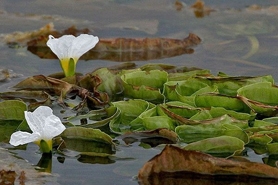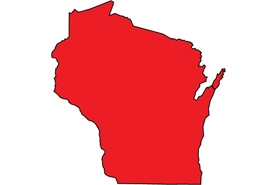Ducklettuce
(Ottelia alismoides)
A common submerged plant in warmer Asian countries is often found in irrigation systems and rice paddies. It spreads by seed and is on the federal noxious weed list in the United States.
Other names for this plant include:
- Scientific names: Stratiotes alismoides
Classification in Wisconsin: Prohibited
- Ecological Threat
-
- It can invade freshwater lakes, reservoirs, ponds, marshes and ditches making boating, fishing and almost all other water activities difficult.
- Degrades water quality by blocking the air-water interface and significantly reducing oxygen levels in the water, impacting underwater animals such as fish.
- Significantly reduces biological diversity: vegetation mats block sunlight, preventing the growth of submerged and emersed plant communities and altering animal communities by blocking access to the water and lowering plants the animals depend on for shelter and nesting.
- Identification
-
Leaves: Oval green leaves submerged, sometimes partly emergent in shallow water.
Flowers: White, three petals with a yellow blotch at the center
Fruits & seeds: tiny oval tan seeds are the primary spread method.
Similar species: May be confused with other aquatic plants such as Echinodorus berteroi.
- Distribution
-
Currently, there have been no reports of ducklettuce in Wisconsin. Have you seen it? Please send us a report.
- Control
-
Mechanical: Tiny populations can be controlled by pulling. Physical removal should be completed before flowering and seed set.
Chemical: Registered aquatic herbicides can temporarily control ducklettuce in small-scale applications. Application of aquatic herbicide requires a permit.
- Resources
- Sources for content:
- Bugwood Wiki Factsheet [exit DNR]
- The University of Florida Center for Aquatic and Invasive Plants: Factsheet [exit DNR]


